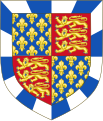John Beaufort, 1st Earl of Somerset
| John Beaufort | |
|---|---|
| House | Beaufort |
| Father | John of Gaunt |
| Mother | Katherine Swynford |
John Beaufort, 1st Marquess of Somerset and 1st Marquess of Dorset, later only 1st Earl of Somerset,
The Beaufort children were declared legitimate twice by parliament, first during the reign of King
Early life


Beaufort's surname (properly de Beaufort, "from Beaufort") probably reflects his birthplace

Between May and September 1390, Beaufort saw military service in North Africa in the
John was created
Later career
After Richard II was deposed by Henry Bolingbroke in 1399, the new king rescinded the titles that had been given to the counter-appellants, and thus John Beaufort became merely
Family
John Beaufort and his wife Margaret Holland, the daughter of Thomas Holland, 2nd Earl of Kent and Alice FitzAlan, had six children. His granddaughter Lady Margaret Beaufort married Edmund Tudor, 1st Earl of Richmond, the son of Dowager Queen Catherine of Valois by Owen Tudor.
John Beaufort, 1st Earl of Somerset, died in the Hospital of St Katharine's by the Tower. He was buried in St Michael's Chapel in Canterbury Cathedral.
His children included the following:
- Henry Beaufort, 2nd Earl of Somerset (1401 – 25 November 1418)
- Margaret Beaufort, Countess of Richmond and Derby, mother of King Henry VII of England
- James I, King of Scots.
- Thomas Beaufort, Count of Perche (1405 – 3 October 1431)
- Edmund Beaufort, 2nd Duke of Somerset (1406 – 22 May 1455)
- Thomas de Courtenay, 13th Earl of Devon.
Appointments
- Lord Warden of the Cinque Ports: 1398
- Admiral of the West: 1397
- Admiral of the Irish Fleet: 1397
- Lieutenant of Aquitaine: 1397
- Admiral of the North and Western Fleets: 9 May 1398 – 15 November 1399
- Lord High Constable of England: 1404
- Admiral of the North and Western Fleets: May 1406 – June 1407
Arms
As a legitimised grandson of King Edward III, Beaufort bore that king's royal arms, differenced by a bordure gobony argent and azure.[12]
-
Early arms of John Beaufort with a bend dexter
-
Beaufort arms (ancient): Royal arms of King Edward III within a bordure compony argent and azure
-
Beaufort arms (England); all within a bordure compony argent and azure[13]
Arms of Beaufort, legitimised progeny of John of Gaunt, third surviving son of King Edward III: Royal arms of King Edward III within a bordure compony argent and azure (see
Ancestry
| Ancestors of John Beaufort, 1st Earl of Somerset | |||||||||||||||||||||||||||||||||||||||||||||||||||||||||||||||||||||||||||||||||||||||||||||||||||||||||||||||||||||||||||||||||||||||||||||||||||||||||||||||||||||||||||||||||||||||||||||||||||||||||||||||||||||||||||||||||||||||||||||||||||||||||||||||||||||||||||||||||||||||||||||||||||||||||||||||||||||||||||||||||||||||||||||||||||||||||||||||
|---|---|---|---|---|---|---|---|---|---|---|---|---|---|---|---|---|---|---|---|---|---|---|---|---|---|---|---|---|---|---|---|---|---|---|---|---|---|---|---|---|---|---|---|---|---|---|---|---|---|---|---|---|---|---|---|---|---|---|---|---|---|---|---|---|---|---|---|---|---|---|---|---|---|---|---|---|---|---|---|---|---|---|---|---|---|---|---|---|---|---|---|---|---|---|---|---|---|---|---|---|---|---|---|---|---|---|---|---|---|---|---|---|---|---|---|---|---|---|---|---|---|---|---|---|---|---|---|---|---|---|---|---|---|---|---|---|---|---|---|---|---|---|---|---|---|---|---|---|---|---|---|---|---|---|---|---|---|---|---|---|---|---|---|---|---|---|---|---|---|---|---|---|---|---|---|---|---|---|---|---|---|---|---|---|---|---|---|---|---|---|---|---|---|---|---|---|---|---|---|---|---|---|---|---|---|---|---|---|---|---|---|---|---|---|---|---|---|---|---|---|---|---|---|---|---|---|---|---|---|---|---|---|---|---|---|---|---|---|---|---|---|---|---|---|---|---|---|---|---|---|---|---|---|---|---|---|---|---|---|---|---|---|---|---|---|---|---|---|---|---|---|---|---|---|---|---|---|---|---|---|---|---|---|---|---|---|---|---|---|---|---|---|---|---|---|---|---|---|---|---|---|---|---|---|---|---|---|---|---|---|---|---|---|---|---|---|---|---|---|---|---|---|---|---|---|---|---|---|---|---|---|---|---|---|---|---|---|---|---|---|---|---|---|---|---|---|---|---|---|---|---|
| |||||||||||||||||||||||||||||||||||||||||||||||||||||||||||||||||||||||||||||||||||||||||||||||||||||||||||||||||||||||||||||||||||||||||||||||||||||||||||||||||||||||||||||||||||||||||||||||||||||||||||||||||||||||||||||||||||||||||||||||||||||||||||||||||||||||||||||||||||||||||||||||||||||||||||||||||||||||||||||||||||||||||||||||||||||||||||||||
Notes
- ^ Chris Skidmore, The Rise of the Tudors: The Family That Changed English History (St. Martin's Press, 2013), 17, 22.
- ^ a b c d e Michael K. Jones and Malcolm G. Underwood, The King's Mother: Lady Margaret Beaufort, Countess of Richmond and Derby, (Cambridge University Press, 1995), 19–20.
- ^ This prohibition was not specified in the original act of 1397, but appears in a 1407 confirmation by Henry IV (Pollard 158), making the ultimate legality of the addition uncertain. While this legal wrangling ultimately caused an enormous amount of bloodshed and destruction, it did result in one of the Beaufort descendants ascending the throne as Henry VII.
- ^ a b c Willement, Thomas, Heraldic Notices of Canterbury Cathedral; with Genealogical and Topographical Notes, London, 1827, p.3, note (e).[1]
- ^ Pollard, A. (1901). . In Lee, Sidney (ed.). Dictionary of National Biography (1st supplement). Vol. 1. London: Smith, Elder & Co.
- ^ Armitage-Smith 196–199
- ^ Willement
- ^ The Beaufort Portcullis was shown on the reverse of British pennies minted between 1971 and 2008.
- ^ G. E. C., ed. Geoffrey F. White. The Complete Peerage. (London: St. Chaterine Press, 1953) Vol. XII, Part 1, p. 40.
- ^ Pollard 158
- ^ Michael K. Jones and Malcolm G. Underwood, The King's Mother: Lady Margaret Beaufort, Countess of Richmond and Derby, 23.
- ^ Marks of Cadency in the British Royal Family
- ^ Debrett's Peerage, 1968, p.125
- ^ Brown 2004.
- ^ Marshall 2003, p. 50.
- ^ Weir 2008, p. 232.
- ^ a b c d Weir 2008, p. 93.
- ^ Weir 2007, p. 6.
- ^ a b Weir 2008, p. 92.
- ^ a b Weir 2008, p. 87.
- ^ a b Weir 2008, p. 89.
References
- Armitage-Smith, Sydney. John of Gaunt, King of Castile and Leon, Duke of Lancaster, &c.. Constable, 1904.
- Brown, M.H. (2004). "Joan [Joan Beaufort] (d. 1445)". doi:10.1093/ref:odnb/14646. Retrieved 21 November 2013. (Subscription or UK public library membershiprequired.) (subscription required)
- ISBN 978-0-19-861412-8. Archived from the original on 7 February 2019. (Subscription or UK public library membershiprequired.)
- Jones, Michael K, and Malcolm G. Underwood, The King's Mother: Lady Margaret Beaufort, Countess of Richmond and Derby. Cambridge University Press, 1992. see especially pp. 17–22
- Marshall, Rosalind (2003). Scottish Queens, 1034-1714. Tuckwell Press.
- ISBN 978-0-224-06321-0.
- ISBN 978-0-09-953973-5.



![Beaufort arms (modern): Quarterly, 1st & 4th: Azure, three fleurs de lis or (France); 2nd & 3rd: Gules, three lions passant guardant in pale or (England); all within a bordure compony argent and azure[13]](http://upload.wikimedia.org/wikipedia/commons/thumb/2/2c/Beaufort_Arms_%28France_modern%29.svg/103px-Beaufort_Arms_%28France_modern%29.svg.png)